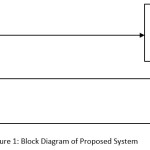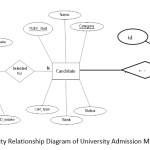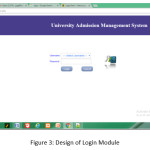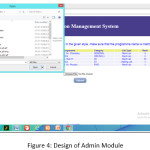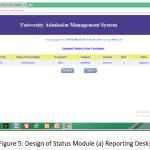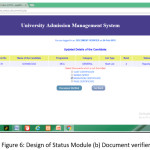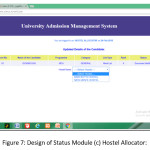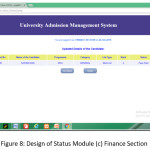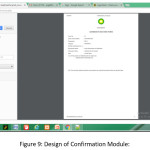Jogamohan Medak1* and Partha Pratim Gogoi2
and Partha Pratim Gogoi2
1North Lakhimpur College (Autonomous), North lakhimpur, Assam, India.
2Tezpur university, Assam, India.
Corresponding Author Email: joga60mca@gmail.com
DOI : http://dx.doi.org/10.13005/ojcst11.01.11
Article Publishing History
Article Received on : 03 January 2018
Article Accepted on : 05 March 2018
Article Published : 07 Mar 2018
Article Metrics
ABSTRACT:
In 21st century, the world is largely dependent on information technology where accuracy, speed and reliability have a huge impact. Manual pen and paper work is going to be replaced by computerized systems for more efficient functioning. In the present scenario, it is difficult to keep track the admission status of a candidate on the day of admission, as the number of candidates applied for higher education institutes is gradually increasing. The aim of the research work is to develop a web based application for University Admission Management System (UAMS) where we can computerize a part of University Admission process to make the admission process easy, efficient and user-friendly.
KEYWORDS:
Information Technology; UAMS (University Admission Management System)
Copy the following to cite this article:
Medak J, Gogoi P. P. Design and Development of University Admission Management System. Orient.J. Comp. Sci. and Technol;11(1)
|
Copy the following to cite this URL:
Medak J, Gogoi P. P. Design and Development of University Admission Management System. Orient.J. Comp. Sci. and Technol. Orient. J. Comp. Sci. and Technol;11(1). Available from: http://www.computerscijournal.org/?p=7751
|
Introduction
The “University Admission Management System” is web-based database software application. Database is a storehouse of information and treated as a unit for information retrieval purpose. Database software is a set of one or more programs that enables users to create, maintain, organize, and retrieve data from database. It is widely used today in organization to maintain employee data, customer data, accounting data etc.
This project entitled as “University Admission Management System” will help to make the admission process much easier. Now-a day, on the day of admission, the flow of candidate is very high and it requires both manual processing and record keeping at the same time that makes the process lengthy and difficult to keep track the admission status of a candidate in multiple departments. In this research, we computerize this part of admission management process which makes the process usually faster, more reliable and more accurate than performing these tasks manually.The “University Admission Management System” is a web-based program aimed to make easier and more convenient way for the admission process in educational institutes.This system is developed and based on Database Management System.The database has been secured as only authorized personnel can modify the data. In this system, HTML (Hypertext Markup Language), CSS (Cascading Style Sheet), and JavaScript is used as client side script and PHP is used as server side script. MySQL database is used as back end software which is a part of XAMPP server. The XAMPP server is open source, free, easy to install apache distribution containing MySQL, PHP (Hypertext Preprocessor), and Perl. The PHP (Hypertext Preprocessor) is a widely-used open source scripting language that is especially suited for web development and can be embedded into HTML.
Objectives
“University Admission Management System” is being developed as a web based system for admission management of various departments in the educational institute that automates and manages the working of admission processes. This system not only takes care of the limitations in the manual pen and paper methods but also provides some additional features, which will help in better management and also make process easier. The specific objectives of this web based application system are:
To computerize candidates and department database.
To computerize the records of availability of intakes in Departments and Hostels.
To manage the admission process with less human effort.
To reduce the workload of official staffs involved in admission process.
To maintain integrity and consistency of data.
Material and Methods
Present System
At present, admission process is done with manual pen and paper method. The number of candidates shortlisted for admission in the institute is respectively large as multiple departments are involved in the process in the same day. Candidates must give their attendance in a paper with his personal details and department details which he/she wants to be enrolled and the status is recorded by an official person as “Reported”. When a candidate gets reported, then he/she has to move to next table for verification of documents. After documents are verified, the candidate gets a receipt of verification and a list containing documents which are verified and which are not submitted. Then the candidate must submit the receipt to the next official person, which allocates Hostel to the candidate. Then the candidate gets a receipt of hostel allocation also. Then, then candidate moves to the next table along with receipt of verification and hostel allocation where he/she has to pay the fees for admission to the department and hostel. When the fees are paid, the candidate finally gets a receipt of payment for admission to department and hostel. The officials also have to manage and update the records of department intake and hostel intake.
As the number of candidates is large and multiple departments are involved in the process, the candidates have to wait for long time in a queue and officials also have to maintain a large number of records in paper and the admission process finally become a lengthy process which involves a lot of hard work and wastage of resources.
As the admission process occurs every year, it becomes essential to simplify the manual process which is highly repetitive and time consuming. The accomplishment of these objectives can help the institution in managing the resources efficiently. The automated process will lead to time saving and get rid of common errors.
Proposed System
The system is divided four categories of modules:
Login Module
This Module is used for security purpose and user authentication.
It is used to create new users, who can login to the web application of admission management system and change password, if a user finds some security problems.
Proper authorization will be done to take care of who is accessing the database – Administrator, Reporting Desk, Document Verifier, Hotel allocator, Finance section, Academic Section.
Admin Module
Admin module is used for Administrative purpose by the Administrator. It is responsible for the following:
This module uploads the shortlisted candidate details as a MS Excel file.
This module inserts documents list which are required to be submitted by the candidates at the time of admission.
This module inserts department name and programme intake details in particular department.
This module inserts Hostel name, intake capacity etc.
This module updates Programme intake, Hostel intake, Candidate details.
This module inserts and deletes the authorized personals’ details involved in the admission process whenever required.
This module deletes data which are no longer needed.
Status Module
In this system the status module updates the status of candidate at the time of admission. By default, status of a candidate is made “listed”. At the day of admission, candidate’s status updates as follows:
The status “Listed” is updated as “Reported” by the Reporting Desk if the candidate gives attendance for admission.
The status “Reported” is updated as “Document verified” by Document verifier after verifying the required documents.
The status “Document verified” is updated as “Hostel Allocated” by Hostel Allocator when candidate is allocated Hostel with hostel details.
The status “Hostel Allocated” is updated as “Fees Paid” by Finance Section after the admission fees are paid.
After fees paid, the status is updated as “Admission Confirmed” by Academic Section and generates admission receipt.
Confirmation Module
This module is used for generating the “Admission Receipt” of the candidate by the Academic Section after admission is confirmed. This receipt contains information such as Form Number, Enrollment Number, Candidate Name, Programme Name, Document list which are not submitted at the time of admission etc.
The following benefits over the manual system are expected to exhibit by the system:
Time Saving: The system will save time than manual paper work.
Speed: The system can retrieve and update data faster than paper work.
Redundancy: Reduce redundancy of data entry.
Cost Saving: Money spent on papers and files can be saved.
Security: Proper Authorization and Security will be added to the system.
Onine Access: User can access data through online which have the authorization to access data.
Design and development of the proposed system
The Entity Relationship Diagram is designed to have a glimpse of the essential entities and the relationships among them within the University Admission Management System. This “University Admission Management System” is designed and based on the database management system. My SQL (Structure Query Language) is used for storing the essential records in the database. This system uses HTML, Cascading Style Sheet, and Java Script as the front-end script and has connectivity with My SQL, the back-end software with the help of PHP (Hypertext Pre-processor), which is widely-used as open source HTML embedded scripting language that is especially suited for web development.
Results and Discussions
The study exhibits that the computerized system has greatly simplified the manual pen and paper work previously exercised in the admission process. The system seems to be user-friendly, time and cost saving and reduces the human efforts involved in the process. Several tasks with huge data like uploaded candidate data file, add programme intake details, downloaded candidate information such as admission confirmed list etc. are performed easily by clicking just few buttons.
The database, containing database tables, is established on a central server. The modules are kept on individual
workstations for different officials and are able to access data after proper authentication from the server.
This system in the current scenario completely meets the requirement which was set when this research was conceived. We can say that the software is ready for implementation which will provide better efficiency and services. It will help the office staffs to reduce their workload and the time spent in unproductive work. The system may have to be modified from time to time to cope with the requirements that would arise with time. Still, this system will help a lot to organize the records of candidate’s status on the day of admission. Hopefully, it would be bugs free in the current form, but even if it’s not, it has been written in such a way that it’s easily maintainable.
Presently the system maintains information about candidates and other programmes offered by the university. The system can be updated to store the information of the research scholars and project fellows in a specific department. The system can also be updated for submitting the candidate application form through online mode and receives admission fees through digital payment system. Further, In future, we would like to recommend certain valuable additions to the system.
Conclusions
The primary objective of our research and development was to automate and computerize the process of admission in the educational institute which would improve the efficiency of the process. Objective has been achieved successfully. The Admin adds information into the database regarding various candidates, departments, programmes, hostels, documents, etc., using various forms provided in the system. At day of admission, status of candidate can be updated as required. Finally, the admission receipt of the candidate can be generated. Database access is made authorized and cannot be accessed by unauthorized personnel. So, this automated and computerized system can be said as secure, efficient and user friendly.
Acknowledgement
The authors are indebted to university office staff for giving this opportunity to work and guidance to complete the research work.
References
- Singh, Rattan, Singh*, Ravinder, Kaur, Harpreet, and Gupta , O. P. “Development of Online Student Course Registration System” Oriental Journal OF Computer Science & Technology. 2016;9(2)66-72.
CrossRef
- Kaur, Harpreet, & Grover, Dinesh. “Design and Development of Online Hospital Management Information System” International Journal of Computer Science Engineering and Information Technology Research. 2013;3(2)79-88.
- Olamide.O, Olusanya, Adedayo. W, Elegbede, and Abiodun. A, Ogunseye. “ Design and Implementation of Hospital Management System Using Java” IOSR Journal of Mobile Computing & Application (IOSR-JMCA). 2015;2(1):32-36
- Williams, Hugh E., and David Lane. “Web database applications with PHP and MySQL”. O’Reilly Media, Inc. 2004.
- Meloni, Julie C. “Sams teach yourself PHP, MySQL and Apache all in one”. Sams Publishing. 2012.
- Ullman, Larry. “PHP advanced for the World Wide Web”. Peachpit Press. 2002.
- Brinzarea, Bogdan, and Audra Hendrix. “Ajax and PHP: Building modern Web applications”. Packt Publishing Ltd. 2009.
- Thomas, D., White-Cinis, J., Lea, C., & Buzzard, M. “PHP MySQL Website Programming: Problem-Design-Solution. A press. 2003.
- Glass, M. K., Le Scouarnec, Y., Naramore, E., Mailer, G., Stolz, J., & Gerner, J. “Beginning PHP, Apache, MySQL Web Development”. John Wiley & Sons. 2004.
- Capps, Stephen P. “Online service registration system and method.” U.S. Patent No. 6,711,682. 23, 2004.
- What is XAMPP” apachefriends.org. Retrieved on February 5, 2018, from https://www.apachefriends.org/index.html.
- “What is PHP” php.net. Retrieved on February 5, 2018, from http://php.net/manual/en/intro-whatis.php.

This work is licensed under a Creative Commons Attribution 4.0 International License.
 and Partha Pratim Gogoi2
and Partha Pratim Gogoi2